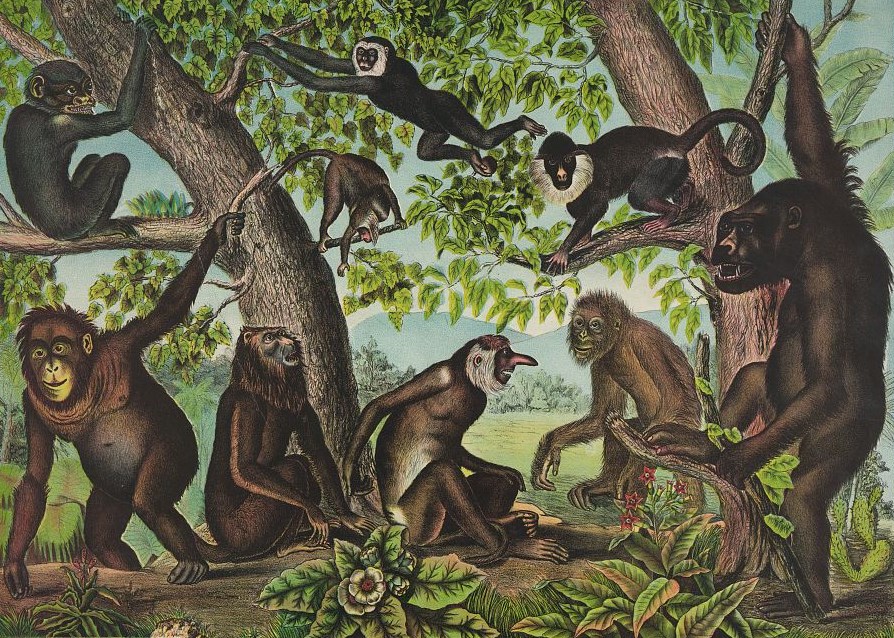Monkeys All the Way Down
Everyone’s likely heard it or seen it written on a protest sign: “I didn’t evolve from a monkey.” It’s a well-worn refrain of those who resist the evolutionary perspective. The pat response we often hear is, “You’re right! We didn’t evolve from monkeys. We share ancestors with them.” However, this talking point isn’t entirely honest.
Yes, we share ancestors with monkeys; we share ancestors with every living thing. But, also, to be clear: We did evolve from monkeys.
It’s impossible to pinpoint with 100 percent certainty which fossil species are our direct ancestors and which are our more distant relatives. This is because the further we go back in time, the fewer the unique traits we share with members of our lineage, and there is often more than one species living at the same time that could be related to any given ancestor. Still, we can trace with a high degree of confidence humankind’s ancestry through fossils all the way back to the first fossils on record almost four billion years ago. One relatively tiny stretch of our lineage, spanning from roughly 40 to 20 million years ago, is populated entirely by animals that we call monkeys.
The fossilized bones and teeth of those ancient monkeys are similar to those of monkeys that exist today in many ways. And yet they’re also different. For example, the oldest fossil monkeys don’t have the distinctive shearing crests on their molars that arose later and are present in many living monkeys, like baboons. Monkeys walking around on Earth today have been evolving for just as long as we have—since the time when our shared fossil-monkey ancestors graced the planet.
Around 20 million years ago, many of those lineages of fossil monkeys kept evolving as “monkeys,” but the lineage that led to us shifted to a different branch on the evolutionary tree, which we have decided to call “apes.” Those fossil apes led to present-day ones including gorillas, chimpanzees, and us. Evolution is occurring constantly, generation upon generation, creating a spectrum of inherited variation over time. To investigate and understand that variation, we often divvy up the continuum into families, or branches on the tree of life. Because they are human inventions, the boundaries around the definitions of “monkey” and “ape” warrant scientific discussion. The necessary but ultimately arbitrary practice of taxonomy is why biological classification is so often debated. Take, for instance, arguments over whether new fossil finds are newly discovered species or variations on known ones, or the row over whether we should call ourselves “apes.”
Along with the other apes (which include chimpanzees, bonobos, gorillas, and orangutans), we evolved from ancient apes. Like modern-day apes and monkeys, we evolved from ancient monkeys. And like all vertebrates with four-limbs, known as tetrapods, we evolved from the same ancient fishes.
The more living relatives we include in a family, the farther back we must go to find that family’s common fossil ancestors. Those ancestors often have more traits in common with some living family members than others. The earliest primates, dating back to over 65 million years ago, resemble lemurs more than they resemble chimpanzees. But, of course, they’re neither. The earliest tetrapods resemble fishes more than they resemble salamanders, but they’re neither. So let’s stop pretending that our ancestors weren’t monkeys, fishes, and slimy single-celled critters. Tip-toeing around common ancestry with monkeys isn’t helpful. To one degree or another, existential questions about life’s ultimate origins run deeper than any raised by evolution.
And, of course, questions that are raised by evolution tend to lead to more questions. Scientific inquiry is a process, and one that is ongoing and incomplete. By definition, science involves uncertainties—questions without known answers. And so perhaps scientists, more than others, are comfortable with the undiscovered. Like when it comes to impenetrable questions about the origins of the universe, some of us can chalk it up to “turtles all the way down” (an infinite tower of stacked-up turtles), chuckle to ourselves, and be done with it. Others cannot, but it’s not because there’s anything wrong with them. The same is true when it comes to feelings about evolutionary thinking and those monkeys we have for uncles. Many people who struggle with these concepts are deeply thoughtful, and being dismissive of them is unhelpful at best.


































